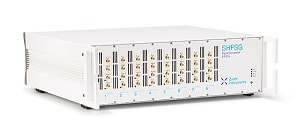Generates error-free, microwave signals that are required to control the state of qubits in quantum computers
 Following the launch of the SHFQA Quantum Analyzer, Zurich Instruments now launches the SHFSG Signal Generator, the first instrument of its kind that can output signals from DC up to 8.5 GHz without the need for mixer calibration and provides spurious-free, low-noise signals in a 1 GHz bandwidth.
Following the launch of the SHFQA Quantum Analyzer, Zurich Instruments now launches the SHFSG Signal Generator, the first instrument of its kind that can output signals from DC up to 8.5 GHz without the need for mixer calibration and provides spurious-free, low-noise signals in a 1 GHz bandwidth.
Specially designed for superconducting and spin qubits, the signal generator takes advantage of the double super-heterodyne frequency conversion technique to ensure better linearity and fewer spurious tones than with standard IQ-mixer-based methods. The SHFSG Signal Generator can be programmed to generate complex gate sequences. As a result, the SHFSG Signal Generator generates clean and stable pulses without requiring users to spend time on mixer calibration or system maintenance.
The SHFSG Signal Generator integrates seamlessly with all devices in the Zurich Instruments Quantum Computing Control System and is available in two variants, one with 4 channels and one with 8 channels.
The SHFSG sets new standards in spectral purity and stability, and ensures that the highest possible gate fidelity is achieved and maintained during operation. As an integral component of the Zurich Instruments Quantum Computing Control System, the SHFSG provides a scalable solution for controlling quantum processors.
The SHFSG generates freely programmable pulse sequences on up to 8 outputs with a signal bandwidth of 1 GHz and a variable carrier frequency up to 8.5 GHz. Such microwave signals are required to control the state of qubits in quantum computers. They previously had to be generated using a combination of arbitrary waveform generators, microwave signal generators and mixer circuits. The SHFSG brings together all these instruments in a single box, and it eliminates the need for time-consuming and error-prone calibration routines.
“The SHFSG sits in the sweet spot between meeting the specialised needs of today’s researchers and keeping an eye on the roadmap for scaling up in the future. It addresses the improvements that truly matter for research teams in quantum computing, yet it is also an instrument versatile enough to cover the variety of approaches pursued in different quantum technology endeavours,” says Dr Mark Kasperczyk, Application Scientist for Quantum Technologies at Zurich Instruments.
Through its ZSync interface and low-latency dynamic sequencing capabilities, the SHFSG supports feedback methods such as active reset and quantum error correction. The ZSync protocol also enables precise and reproducible timing synchronization across instruments, ensuring that gate operations on separate channels are well-aligned even for systems of up to 144 qubit control channels.
The instrument comes in a 4- and an 8-channel variant to suit all setup sizes. The SHFSG represents an important step toward the standardised operation of today’s largest quantum processors. It requires a minimum amount of memory to generate complex signals, hence it reduces the instrument’s communication time – an otherwise critically limiting factor in the tune-up procedures of large quantum computing systems.
As part of the Quantum Computing Control System (QCCS), the SHFSG is seamlessly integrated into setups featuring the HDAWG Arbitrary Waveform Generator and the SHFQA Quantum Analyzer. The Labone QCCS Software allows users to define multi-channel signals involving all instruments in the setup in the form of a pulse-level description abstracted from the hardware. The Labone user interface, already known to Zurich Instruments’ customers, gives access to an overview of all hardware settings and the instrument-level sequence description.
“The SHFSG is the result of long-standing and intensive collaborations with some of Europe’s leading quantum computing groups,” says Dr Paolo Navaretti, Product Manager at Zurich Instruments. “These collaborations established the application know-how that has allowed us to identify the right choices at all levels of product design.”







